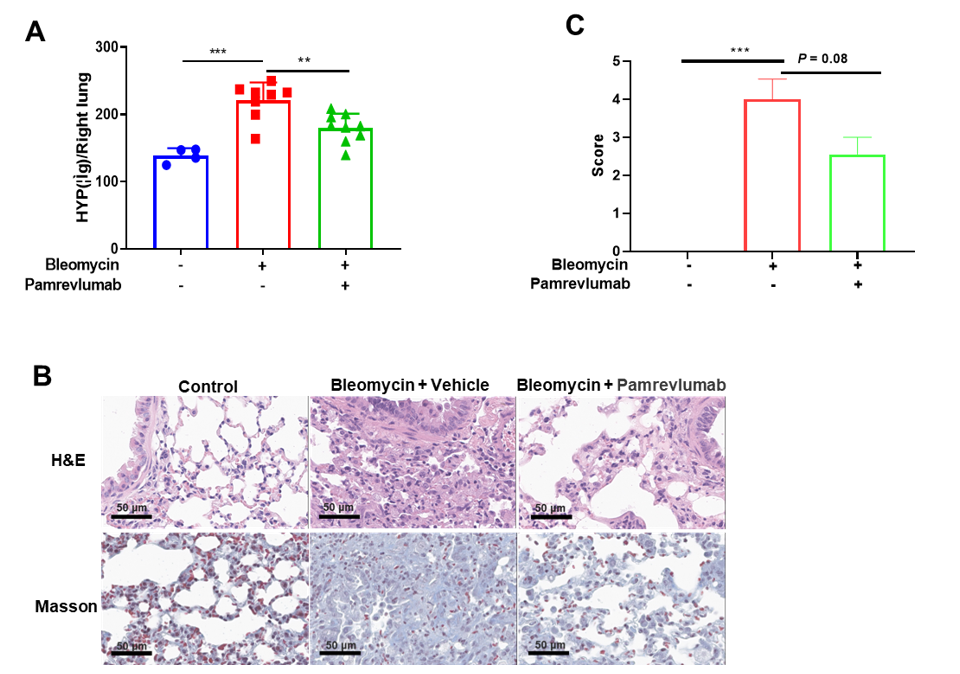Pulmonary fibrosis is a type of end-stage of interstitial lung disease. A variety of factors, including toxic, autoimmune, drug-induced, infectious, or traumatic injuries can cause pulmonary fibrosis. It is characterized by fibroblast proliferation, extracellular matrix aggregation, inflammatory damage and tissue structure destruction [1].
Bleomycin (BLM) is one of the most widely used drugs for inducing lung fibrosis in animals. due to its ability to provoke a histologic lung pattern similar to that described in patients undergoing chemotherapy. BLM is thought to exert its cytotoxic effect by cleaving DNA, inducing an inflammatory response and increasing epithelial apoptosisdose, thus stimulating lung injury and resultant fibrosis [2, 3].
Experimental method

Bleomycin induced Pulmonary Fibrosis in C57BL/6J Mice


Bleomycin induced Pulmonary Fibrosis. C57BL/6J mice administered with bleomycin on day 0, body weight were recorded everyday. Lung tissue were collected at the end of the experiment, Hydroxyproline (HYP) in the lung was measured. Bleomycin produced a loss in body weight (A), a shorter survival rate(B) and an increase in HYP content (C). Pathological examination showed an significant pulmonary fibrosis (D).
Efficacy Validation in Bleomycin induced Pulmonary Fibrosis Model for Pamrevlumab (B-hCNN2 mice)

Effects of pamrevlumab on bleomycin-induced body weight reduction. B-hCCN2 mice administered with bleomycin on day 0, then injected with pamrevlumab or vehicle every two days for 7 times. Body weight were recorded everyday. At the end of the experiment, pamrevlumab treatment was able to improve bleomycin-induced weight loss in B-hCCN2 mice and Pamrevlumab is effective in reducing mortality induced by BLM.

Effects of pamrevlumab on bleomycin-induced Pulmonary fibrosis. Histological analysis of the severity of lung fibrosis in mice after bleomycin induction. Fibrosis in this model was scored by the standard measure of total lung hydroxyproline (HYP) and pathological examination. Bleomycin induced an increase in HYP content. Pamrevlumab treatment reduced HYP content in lung (A). (B) Representative images for Masson staining (top), and H&E staining (bottom). (C) A bar graph figure showing the quantitative mean score of the severity of fibrosis. Values are expressed as mean ± SEM, n=4-8, One-way ANOVA with Dunnett’s post hoc test, *** P<0.001, ** P <0.01.

References
[1] VD Latta, Cecchettini A, Ry SD. Bleomycin in the setting of lung fibrosis induction: From biological mechanisms to counteractions. Pharmacol Res. 2015, 97:122-30.
[2] Williamson JD, Sadofsky LR, Hart SP. The pathogenesis of bleomycin-induced lung injury in animals and its applicability to human idiopathic pulmonary fibrosis. Exp Lung Res. 2015, 41(2):57-73.
[3] Adamson IY, Bowden DH. The pathogenesis of bleomycin-induced pulmonary fibrosis in mice. Am J Pathol. 1974. 77(2):185-97.






 +86-10-56967680
+86-10-56967680 info@bbctg.com.cn
info@bbctg.com.cn